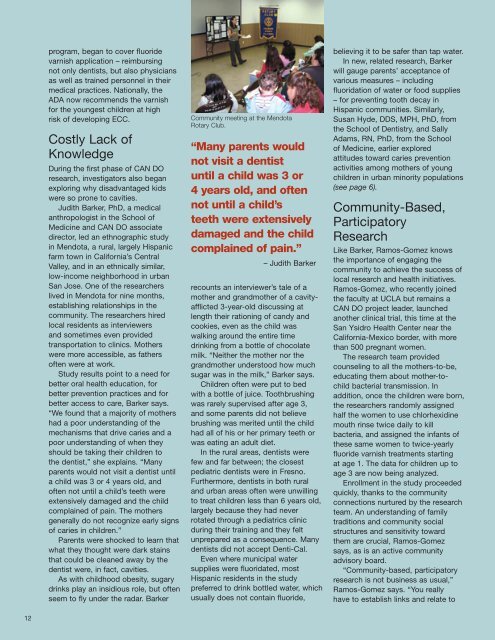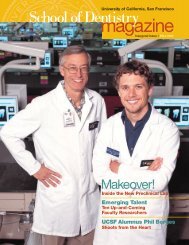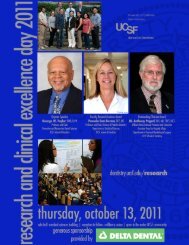2010 - UCSF School of Dentistry - University of California, San ...
2010 - UCSF School of Dentistry - University of California, San ...
2010 - UCSF School of Dentistry - University of California, San ...
You also want an ePaper? Increase the reach of your titles
YUMPU automatically turns print PDFs into web optimized ePapers that Google loves.
12<br />
program, began to cover fluoride<br />
varnish application – reimbursing<br />
not only dentists, but also physicians<br />
as well as trained personnel in their<br />
medical practices. Nationally, the<br />
ADA now recommends the varnish<br />
for the youngest children at high<br />
risk <strong>of</strong> developing ECC.<br />
Costly Lack <strong>of</strong><br />
Knowledge<br />
During the first phase <strong>of</strong> CAN DO<br />
research, investigators also began<br />
exploring why disadvantaged kids<br />
were so prone to cavities.<br />
Judith Barker, PhD, a medical<br />
anthropologist in the <strong>School</strong> <strong>of</strong><br />
Medicine and CAN DO associate<br />
director, led an ethnographic study<br />
in Mendota, a rural, largely Hispanic<br />
farm town in <strong>California</strong>’s Central<br />
Valley, and in an ethnically similar,<br />
low-income neighborhood in urban<br />
<strong>San</strong> Jose. One <strong>of</strong> the researchers<br />
lived in Mendota for nine months,<br />
establishing relationships in the<br />
community. The researchers hired<br />
local residents as interviewers<br />
and sometimes even provided<br />
transportation to clinics. Mothers<br />
were more accessible, as fathers<br />
<strong>of</strong>ten were at work.<br />
Study results point to a need for<br />
better oral health education, for<br />
better prevention practices and for<br />
better access to care, Barker says.<br />
“We found that a majority <strong>of</strong> mothers<br />
had a poor understanding <strong>of</strong> the<br />
mechanisms that drive caries and a<br />
poor understanding <strong>of</strong> when they<br />
should be taking their children to<br />
the dentist,” she explains. “Many<br />
parents would not visit a dentist until<br />
a child was 3 or 4 years old, and<br />
<strong>of</strong>ten not until a child’s teeth were<br />
extensively damaged and the child<br />
complained <strong>of</strong> pain. The mothers<br />
generally do not recognize early signs<br />
<strong>of</strong> caries in children.”<br />
Parents were shocked to learn that<br />
what they thought were dark stains<br />
that could be cleaned away by the<br />
dentist were, in fact, cavities.<br />
As with childhood obesity, sugary<br />
drinks play an insidious role, but <strong>of</strong>ten<br />
seem to fly under the radar. Barker<br />
Community meeting at the Mendota<br />
Rotary Club.<br />
“Many parents would<br />
not visit a dentist<br />
until a child was 3 or<br />
4 years old, and <strong>of</strong>ten<br />
not until a child’s<br />
teeth were extensively<br />
damaged and the child<br />
complained <strong>of</strong> pain.”<br />
– Judith Barker<br />
recounts an interviewer’s tale <strong>of</strong> a<br />
mother and grandmother <strong>of</strong> a cavityafflicted<br />
3-year-old discussing at<br />
length their rationing <strong>of</strong> candy and<br />
cookies, even as the child was<br />
walking around the entire time<br />
drinking from a bottle <strong>of</strong> chocolate<br />
milk. “Neither the mother nor the<br />
grandmother understood how much<br />
sugar was in the milk,” Barker says.<br />
Children <strong>of</strong>ten were put to bed<br />
with a bottle <strong>of</strong> juice. Toothbrushing<br />
was rarely supervised after age 3,<br />
and some parents did not believe<br />
brushing was merited until the child<br />
had all <strong>of</strong> his or her primary teeth or<br />
was eating an adult diet.<br />
In the rural areas, dentists were<br />
few and far between; the closest<br />
pediatric dentists were in Fresno.<br />
Furthermore, dentists in both rural<br />
and urban areas <strong>of</strong>ten were unwilling<br />
to treat children less than 6 years old,<br />
largely because they had never<br />
rotated through a pediatrics clinic<br />
during their training and they felt<br />
unprepared as a consequence. Many<br />
dentists did not accept Denti-Cal.<br />
Even where municipal water<br />
supplies were fluoridated, most<br />
Hispanic residents in the study<br />
preferred to drink bottled water, which<br />
usually does not contain fluoride,<br />
believing it to be safer than tap water.<br />
In new, related research, Barker<br />
will gauge parents’ acceptance <strong>of</strong><br />
various measures – including<br />
fluoridation <strong>of</strong> water or food supplies<br />
– for preventing tooth decay in<br />
Hispanic communities. Similarly,<br />
Susan Hyde, DDS, MPH, PhD, from<br />
the <strong>School</strong> <strong>of</strong> <strong>Dentistry</strong>, and Sally<br />
Adams, RN, PhD, from the <strong>School</strong><br />
<strong>of</strong> Medicine, earlier explored<br />
attitudes toward caries prevention<br />
activities among mothers <strong>of</strong> young<br />
children in urban minority populations<br />
(see page 6).<br />
Community-Based,<br />
Participatory<br />
Research<br />
Like Barker, Ramos-Gomez knows<br />
the importance <strong>of</strong> engaging the<br />
community to achieve the success <strong>of</strong><br />
local research and health initiatives.<br />
Ramos-Gomez, who recently joined<br />
the faculty at UCLA but remains a<br />
CAN DO project leader, launched<br />
another clinical trial, this time at the<br />
<strong>San</strong> Ysidro Health Center near the<br />
<strong>California</strong>-Mexico border, with more<br />
than 500 pregnant women.<br />
The research team provided<br />
counseling to all the mothers-to-be,<br />
educating them about mother-tochild<br />
bacterial transmission. In<br />
addition, once the children were born,<br />
the researchers randomly assigned<br />
half the women to use chlorhexidine<br />
mouth rinse twice daily to kill<br />
bacteria, and assigned the infants <strong>of</strong><br />
these same women to twice-yearly<br />
fluoride varnish treatments starting<br />
at age 1. The data for children up to<br />
age 3 are now being analyzed.<br />
Enrollment in the study proceeded<br />
quickly, thanks to the community<br />
connections nurtured by the research<br />
team. An understanding <strong>of</strong> family<br />
traditions and community social<br />
structures and sensitivity toward<br />
them are crucial, Ramos-Gomez<br />
says, as is an active community<br />
advisory board.<br />
“Community-based, participatory<br />
research is not business as usual,”<br />
Ramos-Gomez says. “You really<br />
have to establish links and relate to




